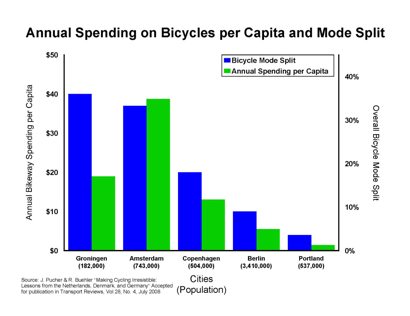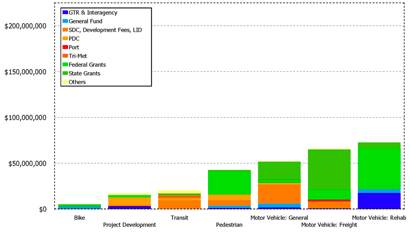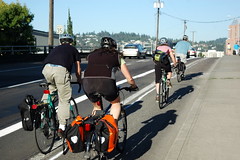A comparison of bikeway spending and resulting bike use shows that Portland is way behind in opening up its pocketbook to pedaling.
Along with the rising profile of bike boxes, bike boulevards, bike trails, and bikes in general in Portland will come an increased scrutiny on how that infrastructure is paid for. Skeptics (or just plain enemies) of the non-motorized transportation revolution are sure to use the financial question as a way to try and stop the rising tide of bike spending and encouragement in Portland.
“Bicycling has been a very cheap date.”
–City of Portland bike coordinator Roger Geller
But regardless of naysayers, the fact is nearly every major bureaucrat and politician in Portland, and a majority of people that live here (an assumption, I admit) want to see increased bike use (or at least wouldn’t admit publicly otherwise).
Even Portland’s official Comprehensive Plan, which is intended to “guide the future growth and development of the city,” states (in section TRN-6.01) one of our goals is to:
“Make the bicycle an integral part of daily life in Portland, particularly for trips of less than five miles, by implementing a bikeway network, providing end-of-trip facilities, improving bicycle/transit integration, encouraging bicycle use, and making bicycling safer.”
It doesn’t take an activist to realize that bikes are a clean, cheap, and readily available solution to a host of major problems facing not just Portland and the rest of America, but the entire planet as well.
So, if we truly want to increase the amount of people who go by bike — and adequately and safely serve those who already do — we can’t be afraid to put our money where our mouths are.
- 28: Percentage of SE Portland residents
who use their bike as a primary
or secondary commute vehicle. - 16: Percentage of Portlanders citywide
who use their bike as a primary or
secondary commute vehicle. - 6: Percentage of Portlanders citywide
who regularly bike to work. - 0.7: Percentage of PDOT’s capital
budget spent on bicycle infrastructure. - $37.00: Amount spent per capita/per year
on bikes in Amsterdam - $1.28: Amount spent per capita/per year
on bikes in Portland.
A recent survey by the City Auditor showed that citywide, 16% of Portlanders use a bike as either their primary or secondary commute vehicle. In Northeast and Southeast Portland that number jumps up to 22% and 28% respectively.
However, despite these numbers (and all the other benefits biking brings to our city), the faucet is still barely at a trickle.
Let’s review: 16% of Portlanders rides bikes as transportation at least occasionally (and 6% do so regularly), yet we get less than 1% of PDOT’s capital infrastructure budget. And, when we do line up for new funding streams (like Commissioner Adams’ Safe and Sound Streets initiative), our piece becomes the center of media attention, partisan politics, and we’re forced to justify our tiny piece of the pie (which in the case above was a mere $24 million out of $450 million).
Yet, even with this paltry piece of the spending pie, Portland has built a bike network and culture envied around the world and it is clearly the most bike-centric metropolis in America. The take-away from that: Bikes are the best transportation investment money can buy. Or, as PDOT’s bike coordinator Roger Geller likes to put it, “bicycling is a very cheap date”.
Just imagine what will happen once we begin to invest in our bike infrastructure like we should.
For a glimpse at what’s possible, check out the graph below. It compares the annual per capita bikeway spending of Portland with four European cities alongside the percentage of people that use bikes to get around. On one end of the spectrum is Portland with less than $2.00 per capita going to bikes and on the other is Amsterdam, with close to $40.00 being spent per capita…

(Click to enlarge)
The data comes from Rutgers University “bicycling scholar” John Pucher and it was recently used as part of a presentation at the National Bike Summit by PDOT bicycle coordinator Roger Geller.
Geller has been leading the charge at PDOT with his mantra of wanting to build a “world class bike city in an American context,” but even PDOT’s proposed capital funding for the next four years doesn’t look too great for bikeway spending (that little green line at the very left is for bikes and the three bars at the right are for motor vehicles):

Click to enlarge
So where will the money come from? Luckily, bike planners have evolved (out of necessity) to be very opportunistic predators when it comes to finding money for bike projects. I’m confident in their ability to keep expanding our bike network, but if we really expect them to build us a “world class bike city” in any context, I wish they could spend less time looking for money and more time figuring out where to spend it.


